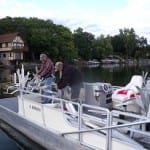
Members of the Lake Fork Sportsman’s Association (LFSA) partnered with Texas Parks and Wildlife Department’s (TPWD) Inland Fisheries Division staff in making fish habitat improvements at Lake Fork on November 30.
Taking advantage of drought-induced low water levels that have exposed shorelines, teams planted 400 buttonbush plants at various sites. Buttonbush (Cephalanthus occidentalis), a native woody shrub commonly called “buckbrush,” was chosen in an attempt to establish woody cover for fishes. When inundated by water, it helps provide great bass fishing.
See the dozens of unique artificial fish habitat models, fish attractors and fish cover used at fishiding.com, the leader in science based, proven, fish protection.
Lake Fork has had a long history of relatively stable water levels. This has been advantageous in that it has mostly translated into stable aquatic habitat and fish production. However, during the recent drought the disadvantage of this stability became evident. The lake elevation has dropped to an all-time record low, exposing shorelines and reducing cover which provides young fish shelter from predation and ambush cover for feeding adult sportfish. Lake Fork will likely be subject to more water level fluctuations in the future as the City of Dallas increases pumping operations on the lake, especially if the current drought persists.
In lakes where there are prolonged draw-downs, communities of assorted plants will colonize exposed sediment. These include emergent aquatic plants such as smartweed, sedges and rushes, along with a variety of terrestrial plants including shrubs and trees. Woody plants such as willows will grow rapidly along the shoreline, and when substantial amounts of rainfall return to the watershed and the lake elevation rises enough, the plants can become partially or totally inundated. The “cover” that these plants provide creates shelter for fish and acts as a substrate for the establishment of many organisms in the aquatic food chain. Some of the woodier plants are persistent and will survive for many years and provide benefits to the ecosystem.
The first step in this habitat enhancement plan materialized in March 2011, when the LFSA purchased 1,000 bare-root buttonbush plants from a local tree nursery and planted them at selected locations throughout the reservoir. Survival of these small plants, most less than two feet in length, was low. At some of the planting sites they were trampled by feral hogs.
The second stage in LFSA’s habitat project began to take shape this past summer. The opportunity to purchase larger plants presented itself when a fish farmer in Columbus, Texas, approached TPWD looking for potential customers for 400 two-year old buttonbush plants. These larger plants should experience better survival. The LFSA agreed to underwrite the majority ($1,900) of the purchase price, and TPWD contributed $650. Bushes were planted at different elevations to hedge against future water-level changes.Written on: 12/02/2011 by: TPWD
———
On the Net:
- Videos of the planting: https://www.facebook.com/tpwdif3b?ref=ts
